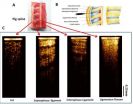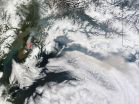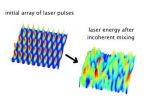(Press-News.org) Economists have long touted the importance of quantifying nature's value — from the natural treatment of pollution by wetlands to the carbon storage capacity of forests — and including it in measures of national wealth.
But so far, achieving an actual measurable value for this "natural capital" has remained elusive, says Eli Fenichel, an assistant professor of bioeconomics and ecosystems management at the Yale School of Forestry & Environmental Studies.
In a new paper, Fenichel and co-author Joshua Abbott of Arizona State University report developing an approach to calculate a fair and consistent price for natural capital stocks that is grounded in the same theory of economic capital that governs the pricing of other capital assets, from stock prices to factories.
The researchers show the importance of valuing natural resources as a capital asset that stores wealth for the long term rather than simply as commodities that are bought and sold in the day-to-day by developing a formula that combines economic with biophysical measurements and quantifies the feedbacks between nature and human behavior.
"Our approach to valuation illustrates the critical importance of understanding the feedbacks between the state of natural capital stocks, human behavior impacting those stocks, and the role of policy in shaping that feedback," Fenichel said.
Reef fish in Gulf of Mexico provide a useful example. According to the study, live reef fish in the Gulf were worth just over $3 per pound in 2004. Three years later, when policymakers reformed and improved management by introducing a conservation incentive, allowing fishermen to trade the rights to catch a pound of fish — and thus creating a market for the fish as a capital asset — the price per pound jumped to just below $9 per pound.
Overall, their analysis found that the Gulf's reef fish contributed more than $256 million to the national wealth in 2004 — and perhaps triple that amount by 2007 as a result of the management change. But existing models of national wealth have neglected these contributions, Fenichel said.
The paper was published as the lead article in the inaugural issue of the Journal of the Association of Environmental and Resource Economists.
Although economists have attempted for decades to put a price on nature, earlier models failed to measure the "opportunity cost" of losing future units of natural capital stock: for example, the cost of harvesting a fish today rather than letting it reproduce and harvesting some of its babies later.
"We have learned a lot about natural resource management using models that ask how would we make decisions under idealized market conditions," Fenichel said. "But those models generate prices based on the assumption that resource use is optimally balanced through time — thus revealing the maximum potential value of a natural asset. Unfortunately, most natural capital or natural stocks are not particularly well managed."
The new framework moves beyond idealized management by basing prices on policies that are actually in place, inefficient as they may be, to create an accurate picture of a society's wealth, the authors say. These insights can inform policies that would manage natural resources more sustainably.
"It's similar to investors being able to see the share price of a firm, assess the capital it holds, and then determine whether they can do a better job managing the company," said Abbott, an associate professor at ASU's School of Sustainability. In that scenario, the investor can reorganize the firm, improving management, and enjoy the increase in wealth as the share price increases. "The problem with nature," he says, "is that we don't see those share prices for natural assets, which is why an approach like this is needed."
Fenichel said, "I'd love to see this approach applied to all U.S. fish stocks, forests, groundwater, and other resources. Until we have credible prices for natural assets that policymakers can put into national accounting schemes, the value of these natural assets is treated as if it were 'zero.'
"And we're not going to effectively manage those things that matter most to us as long as we're valuing them as 'zero.'"
Critically, he added, the paper also calls attention to the importance of interdisciplinary perspective when assessing the value for natural systems. "This paper lays out a strong, conceptual framework for how economists and natural scientists must come together to really understand how we are currently valuing our environment."
INFORMATION: END
Moving 'natural capital' from metaphor to reality
Researchers develop approach to calculate fair and consistent price for natural capital stocks
2014-05-27
ELSE PRESS RELEASES FROM THIS DATE:
Eastern Pacific season off with a bang: Amanda is first major hurricane
2014-05-27
The first tropical cyclone of the Eastern Pacific hurricane season grew into a major hurricane as Hurricane Amanda reached Category 4 status on the Saffir-Simpson scale over the Memorial Day holiday weekend. NASA and NOAA satellites watched as Amanda developed an eye while strengthening.
Fortunately, Amanda is far enough away from coastal Mexico that no watches or warnings are in effect today, May 27.
On Sunday, May 25, Amanda strengthened into the first Major Hurricane in the Eastern Pacific Ocean. Maximum sustained winds were near 155 mph (250 kph). Amanda was centered ...
Precision-guided epidurals and better blood monitors
2014-05-27
WASHINGTON, May 27, 2014—The march of modern medicine is often driven by revolutions in medical imaging. When technology advances, doctors are better able to peer deeply into human tissues, and thus able to detect, diagnose and treat human diseases more effectively.
Now, researchers have taken an established imaging technology called "optical coherence tomography," or OCT, and integrated it with other instruments to bring about the next revolution in imaging by helping doctors provide safer, less painful and more effective care for women in labor and people with diabetic ...
Update on Funny River Fire, southern Alaska
2014-05-27
NASA's Terra satellite passed over the central Alaska and the Moderate Resolution Imaging Spectroradiometer (MODIS) instrument that flies aboard captured an image of smoke and hot spots from the Funny River Fire in southern Alaska on May 26 at 21:45 UTC (5:45 p.m. EDT). The heat from the fire appears red in the imagery and the smoke appears light brown.
On May 26 at 9:30 a.m. local time, the Alaska Interagency Incident Management Type 2 Team reported on the status of the fire through the multi-agency Incident Information System known as Inciweb. At that time the fire ...
More access to health care may lead to unnecessary mammograms
2014-05-27
GALVESTON —Researchers have concluded that providing better access to health care may lead to the overuse of mammograms for women who regularly see a primary care physician and who have a limited life expectancy.
The cautionary note from researchers at the University of Texas Medical Branch at Galveston is that screening women in this category could subject them "to greater risks of physical, emotional and economic suffering."
Dr. Alai Tan, a senior biostatistician in UTMB's Sealy Center on Aging and lead author of the study, said that "there has been little systematic ...
Smaller accelerators for particle physics?
2014-05-27
WASHINGTON D.C., May 27, 2014 -- It took every inch of the Large Hadron Collider's 17-mile length to accelerate particles to energies high enough to discover the Higgs boson. Now, imagine an accelerator that could do the same thing in, say, the length of a football field. Or less.
That is the promise of laser-plasma accelerators, which use lasers instead of high-power radio-frequency waves to energize electrons in very short distances. Scientists have grappled with building these devices for two decades, and a new theoretical study predicts that this may be easier than ...
New epilepsy treatment offers 'on demand' seizure suppression
2014-05-27
A new treatment for drug-resistant epilepsy with the potential to suppress seizures 'on demand' with a pill, similar to how you might take painkillers when you feel a headache coming on, has been developed by UCL (University College London) researchers funded by the Wellcome Trust.
The treatment, described in Nature Communications, combines genetic and chemical approaches to suppress seizures without disrupting normal brain function. The technique was demonstrated in rodents but in future we could see people controlling seizures on-demand with a simple pill.
Epilepsy ...
Light-colored butterflies and dragonflies thriving as European climate warms
2014-05-27
Butterflies and dragonflies with lighter colours are out-competing darker-coloured insects in the face of climate change.
In a new study published in Nature Communications, scientists from Imperial College London, Philipps-University Marburg and University of Copenhagen have shown that as the climate warms across Europe, communities of butterflies and dragonflies consist of more lighter coloured species. Darker coloured species are retreating northwards to cooler areas, but lighter coloured species are also moving their geographical range north as Europe gets warmer.
For ...
Climate warming favors light-colored insects in Europe
2014-05-27
Climate changeButterflies and dragonflies with a lighter shade of colour do better in warmer areas of Europe. This gives them a competitive advantage over the darker insects in the face of climate change. Changes in Europe's insect assemblages due to warming can already be seen for dragonflies, shows a study recently published in Nature Communications.
"When studying biodiversity, we lack general rules about why certain species occur where they do. With this research we've been able to show that butterfly and dragonfly species across Europe are distributed according to ...
Why are girl babies winning in the battle for survival?
2014-05-27
Sexual inequality between boys and girls starts as early as in the mother's womb – but how and why this occurs could be a key to preventing higher rates of preterm birth, stillbirth and neonatal death among boys.
A team from the University of Adelaide's Robinson Research Institute has been studying the underlying genetic and developmental reasons why male babies generally have worse outcomes than females, with significantly increased rates of pregnancy complications and poor health outcomes for males.
The results - published today in the journal Molecular Human Reproduction ...
Medical mechanics
2014-05-27
Removing a malignant tumor from the head of the pancreas is a risky and demanding operation. The surgeon must carefully navigate around the stomach, the gallbladder, the bile duct, lymph nodes, and several high-pressure blood vessels.
But an inexpensive device designed by Harvard engineering students and a surgeon at Beth Israel Deaconess Medical Center offers surgeons a confident grip throughout the delicate procedure. The gentle grasper, equipped with rubberized pressure sensors, has three slender fingers that can slip through a very small incision and tease cancerous ...
LAST 30 PRESS RELEASES:
New software sheds light on cancer’s hidden genetic networks
UT Health San Antonio awarded $3 million in CPRIT grants to bolster cancer research and prevention efforts in South Texas
Third symposium spotlights global challenge of new contaminants in China’s fight against pollution
From straw to soil harmony: International team reveals how biochar supercharges carbon-smart farming
Myeloma: How AI is redrawing the map of cancer care
Manhattan E. Charurat, Ph.D., MHS invested as the Homer and Martha Gudelsky Distinguished Professor in Medicine at the University of Maryland School of Medicine
Insilico Medicine’s Pharma.AI Q4 Winter Launch Recap: Revolutionizing drug discovery with cutting-edge AI innovations, accelerating the path to pharmaceutical superintelligence
Nanoplastics have diet-dependent impacts on digestive system health
Brain neuron death occurs throughout life and increases with age, a natural human protein drug may halt neuron death in Alzheimer’s disease
SPIE and CLP announce the recipients of the 2025 Advanced Photonics Young Innovator Award
Lessons from the Caldor Fire’s Christmas Valley ‘Miracle’
Ant societies rose by trading individual protection for collective power
Research reveals how ancient viral DNA shapes early embryonic development
A molecular gatekeeper that controls protein synthesis
New ‘cloaking device’ concept to shield sensitive tech from magnetic fields
Researchers show impact of mountain building and climate change on alpine biodiversity
Study models the transition from Neanderthals to modern humans in Europe
University of Phoenix College of Doctoral Studies releases white paper on AI-driven skilling to reduce burnout and restore worker autonomy
AIs fail at the game of visual “telephone”
The levers for a sustainable food system
Potential changes in US homelessness by ending federal support for housing first programs
Vulnerability of large language models to prompt injection when providing medical advice
Researchers develop new system for high-energy-density, long-life, multi-electron transfer bromine-based flow batteries
Ending federal support for housing first programs could increase U.S. homelessness by 5% in one year, new JAMA study finds
New research uncovers molecular ‘safety switch’ shielding cancers from immune attack
Bacteria resisting viral infection can still sink carbon to ocean floor
Younger biological age may increase depression risk in older women during COVID-19
Bharat Innovates 2026 National Basecamp Showcases India’s Most Promising Deep-Tech Ventures
Here’s what determines whether your income level rises or falls
SCIE indexation achievement: Celebrate with Space: Science & Technology
[Press-News.org] Moving 'natural capital' from metaphor to realityResearchers develop approach to calculate fair and consistent price for natural capital stocks




